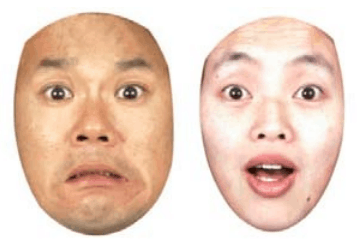Are You Surprised or Angry?
Robert Henderson, American Renaissance, August 2010

The liberal internationalist dream of one big happy human family divided only by cultural differences recently took a knock. Research published in the September 29, 2009, issue of Current Biology by a team at Glasgow University in Scotland suggests that whites and East Asians interpret facial expressions in significantly different ways. The findings have sobering implications for inter-racial understanding because they raise the possibility that different races interpret the most important non-verbal human signals — facial expressions — either differently or with different degrees of accuracy.
The research samples were small — just 13 Europeans and 13 East Asians, of which 12 were Chinese and one was Japanese. The subjects were shown photographs of both white and Asian faces expressing emotions that were classified as Happiness, Surprise, Fear, Disgust, Anger, Sadness, and Neutral. The emotions were categorized according to the Facial Action Coding System (FACS), that is, according to the facial muscles that are used.
The research found that the whites and Asians differed significantly both in the way they scrutinized faces and in how well they identified the emotions. Whites correctly interpreted all the expressions all the time, but one third of the time Asians confused fear with surprise, and disgust with anger. Interestingly, they were less likely to make mistakes when they were shown photographs of Asians rather than whites. There was no difference in the way whites and Asians interpreted faces expressing sadness, happiness, and neutral feelings.
Fear and surprise, and disgust and anger are related pairs. Indeed, they may be experienced at the same time or in rapid succession. Probably because they are emotional cousins, they result in similar and perhaps confusing facial expressions. Happiness and sadness, on the other hand, are diametrically opposed, and are presumably more easily recognized.
The Glasgow University team tracked the subjects’ eye movements, and found that the two groups looked at faces differently. Asians concentrated mainly on the eyes while whites concentrated equally on the eyes and mouth. Asians therefore have difficulty distinguishing expressions in which the eyes take on similar appearances. Whites, who use two reference areas, are better at interpreting such expressions.
The difference in the way the two groups scan faces may explain why whites and Asians use different emoticons (typed characters that represent emotions). Whites use parentheses to represent the mouth: Happy is “:)” and “:(” means sad. Asians represent the eyes, with “^.^” meaning happy and “;_;” meaning sad.
The Glasgow researchers concluded that culture accounts for how Asians and whites scan faces. Perhaps. Some group differences in behavior are clearly cultural and not inherent: For example, for Chinese and Japanese, the color of death is white but for Europeans it is black. However, the way we interpret emotions from facial expressions is unlikely to be culturally determined. We do not have to be taught to recognize expressions; we understand them without thinking about them. It may be that as a child develops, he associates certain expressions with certain types of behavior, but this would not explain the different ways in which Europeans and Asians scan faces. It is hard to think of a cultural practice that would lead Asians to concentrate on the eyes, and a different cultural practice that would encourage whites to concentrate on both eyes and mouth. It is not clear how such a cultural difference would operate because scanning faces is so natural even very young babies do it.
But if there is a genetic racial difference in the way people scan faces, how did it arise? Perhaps Asian languages cause speakers to move the mouth less energetically than do European languages. Perhaps the range of physical expression in Asian faces is less around the mouth than it is in whites. If that were so, the most efficient thing for Asians to do would be to concentrate on the eyes.
If this is true — and, indeed, this is highly speculative — it may explain the age-old Western complaint that Asians are “inscrutable.” If they are actually less expressive than whites in the region of the mouth, it would mean that whites, who scan the mouth as carefully as the eyes, are searching in vain for emotional cues that are not there.

Examples of Asian faces expressing fear and surprise that were used in the study.
On the other hand, it may also be that Asians have other ways to detect emotion and have less need to read faces. As any dog or cat owner knows, animals can be very sensitive to non-verbal signals that indicate human emotional states. The ancestors of homo sapiens must have interpreted emotions the same way. Their language was primitive, and interpreting non-verbal signals of all kinds, including facial expressions, would have been more important than such abilities are to modern men living in sophisticated societies.
People read emotions through body language, and the nuances of speech. They may also use less obvious clues, such as pheromones. The Glasgow research measured only one way of interpreting emotions. It seems to have uncovered a racial difference that is significant as far as it goes, but it did not go into the whole range of verbal and non-verbal clues people can use. It may be that Asians, while less accomplished than whites at pure facial recognition, are just as good or even better than whites at identifying emotions in real-life situations in which the full range of emotional clues is available.
Or it could be that Asians are consistently less able than whites to read emotional clues correctly, whether they be facial expressions, body language, or tone of voice. It is not out of the question that detecting emotions was simply less important in the social environment Asians built for themselves.
Patterns of misidentification
There is a suggestion of this possibility in another important finding by the Glasgow researchers: that there was a pattern to the way Asians misidentified the expressions. They showed a bias towards the softer, less threatening emotions. Given a choice between fear and surprise they chose surprise, and between disgust and anger, they chose disgust.
The researchers again concluded that this tendency was culturally determined, but this is not necessarily so. Studies of twins and other siblings have repeatedly shown that personality is subject to genetic influences. Personality is therefore subject to natural selection, and different races differ in what could be called “average personality” as much as they do in average intelligence.
Asians could be genetically slanted towards interpreting facial expressions in less threatening ways, and these differences seem to be consistent with what appear to be innate racial differences in behavior. A quarter of a century ago, in his seminal book Sociobiology (abridged edition, p. 274.), Edward Wilson reported on infants:
[Studies have]demonstrated marked racial differences in locomotion, posture, muscular tone and emotional response of newborn infants that cannot reasonably be explained as the result of training or even conditioning within the womb. Chinese-American newborns, for example, tend to be less changeable, less easily perturbed by noise and movement, better able to adjust to new stimuli and discomfort, and quicker to calm themselves than Caucasian-American infants.
More recently, Professor Phil Rushton has written:
Temperamental differences, measured objectively by activity recorders attached to arms and legs, show up in babies. African babies are more active sooner and develop earlier than white babies who, in turn, are more active than East Asian babies. Motor behavior is a highly stable individual difference variable. Even among whites, activity level measured during free play shows highly significant negative correlations with IQ: more restrained children average higher intellects. (“Solving the IQ Conundrum,” VDARE.com, Aug. 12, 2004)
In my American Renaissance article of October 2009 (“Why Have Asians Not Dominated?”) I wrote:
Despite their higher average IQ, Asians have failed to become the culturally dominant race, probably because innate personality traits work against them. Compared to Europeans, they are passive, unquestioning, and lacking in initiative.
If a society favors the quiescent personality — one that interprets facial expressions as softer and less threatening than they really are — those with genes that tend towards such personalities will be favored, but that raises the question of why a society would favor particular personalities. This could conceivably be a blind throw of the genetic dice, but personality is such a central part of human society that it is difficult to see how natural selection would have produced such a trait accidentally, or as a consequence of some other evolutionary advantage that was even more important than personality. The answer probably lies in the implications of being a social animal.
People have many opportunities to remodel behavior, and recent findings suggest that evolution has been very rapid during the last few thousand years. Those who become powerful can destroy their enemies and promote their friends, and do it on a scale — including genocide — not possible for any other social animal. For several thousand years, East Asians have lived in circumstances in which a ruler or small group could assert power over large populations. Any encouragement of specific character traits by the dominant members of society would help spread the genes for those traits within the population.
At the same time, certain evolved Asian character traits may have directly influenced the kind of societies Asians built. From the beginning of historical times there appears to have been a clear difference in mentality between Europeans and East Asians.
In Europe there were always strong tendencies to resist absolutism and centralization of power, a fact even the most powerful rulers had to take into account if they were to survive. Twenty-five centuries ago, the Greeks demonstrated over and over their refusal to accept autocracy. Even at their most despotic, Roman emperors found it politic to keep at least the forms of the power-sharing structures of the Roman Republic and to appease the masses with bread and circuses.
The post-Roman European world was not a world of dictators, but of monarchs precariously sitting on their thrones. Mediaeval Europe saw the widespread rise of representative assemblies, and even the powerful, so-called absolute monarchies that crushed or emasculated their assemblies between the late 16th and late 18th centuries were unable to change the general mentality of their people. They fell in the 19th century to democratic impulses and national self-determination. Nor were attempts to impose the divine right of kings ever successful.
Chinese history tells a different story. It is a catalogue not just of autocracy but autocracy on a grand scale, a constant search for a central authority with unqualified power. That does not mean China was always a single, centralized state.
The first unification of China is usually dated from the short-lived Chin dynasty (221-207 BC) and for approximately half the period since then the country has been divided. Nonetheless there have been many successful attempts to establish autocratic, unified control, the last of which is the present Communist regime. Before the Communists, the last successful traditional autocracy was that of the Manchu, who established the Ching dynasty in 1644 and who might still be ruling had Europe and the USA not intruded into Chinese politics during the 19th century.
In their long history as an independent people, the Chinese never developed a political system that went beyond that of the God-appointed/God-related ruler — the Chinese emperor’s Mandate of Heaven. There were frequent rebellions, but even if they were not simply uprisings by local warlords or disloyal imperial servants, they did not seek a form of government that spread power to more people but the replacement of a bad ruler with one considered just in the Confucian sense, a ruler who would behave temperately and for the good of those he ruled, but who would still be an absolute monarch. Confucianism is an expression of submission, because it defines right conduct as submission: child to father, wife to husband, subject to those higher in the hierarchy.

Another face from the study: a white
woman showing fear.
The experience of China in modern times reinforces the idea that Asians are more prone to accepted social circumstances that require submission. In 70 years, the country has moved from the fractured quasi-colonial situation prior to 1949, through the madness of the Mao dictatorship, to the present curious hybrid of capitalism and Communist political and social control. What is striking is not that through this period the governing ideology has changed radically, but that the Chinese have not seriously challenged the idea of a central ruling power. The post-war Japanese experience is somewhat different, but it is a democracy with a distinctly Asian flavor of conformity, and before conquest and occupation by Americans, Japan was a highly structured and authoritarian society that never developed beyond the God-emperor stage.
Cross-cultural communication
The Asian personality may be well adapted to Asian societies but, assuming it reflects racial differences that cannot be easily effaced by cultural influences, what does it mean for the current vogue of integration and multiculturalism? The Glasgow University researchers were brave enough to note that “our results question the universality of human facial expressions of emotion, highlighting their true complexity, with critical consequences for cross-cultural communication and globalization.”
Just so. If human beings do not have a common understanding on something as basic as recognizing emotions, there is much scope for friction. It is also significant that Asians were better able to interpret emotions in the faces of fellow Asians. Misunderstandings are more likely in multi-racial settings, and in racially mixed societies people tend to associate with people of their own race. The Glasgow findings suggest what one of the reasons for that may be.
It will be interesting to see if these results are replicated with larger samples and with different groups. A comparison of Japanese natives with Japanese Americans, for example, would suggest the extent to which the racial differences the Glasgow team found can be changed by environment. Comparisons of black Americans, white Americans, and Africans might also yield interesting results. Science continues to raise uncomfortable obstacles to the mixed-race, egalitarian world our rulers are planning for us.















